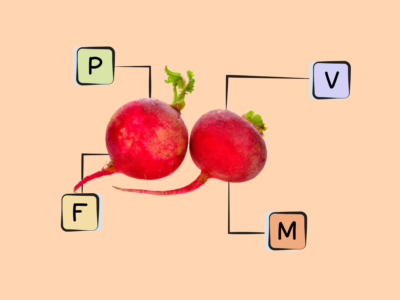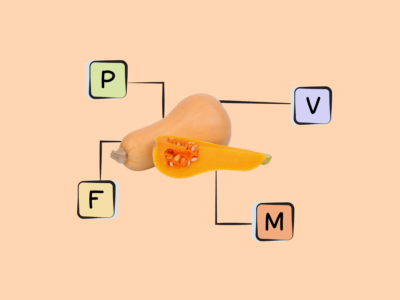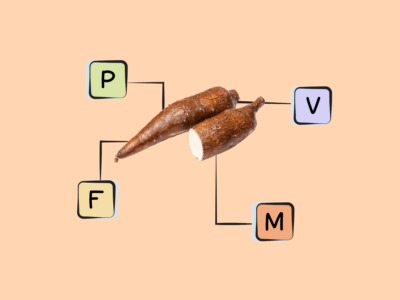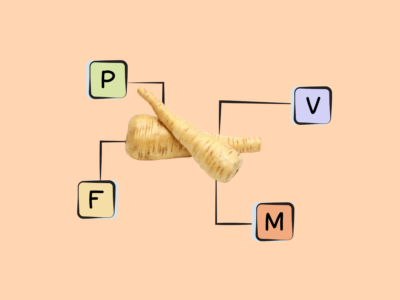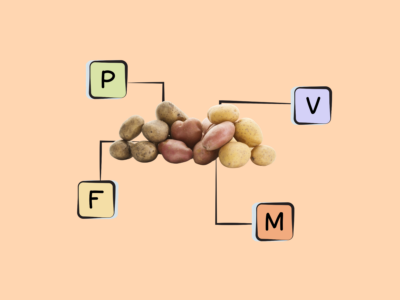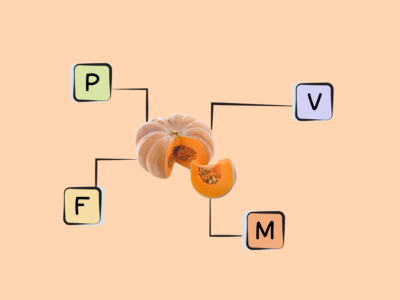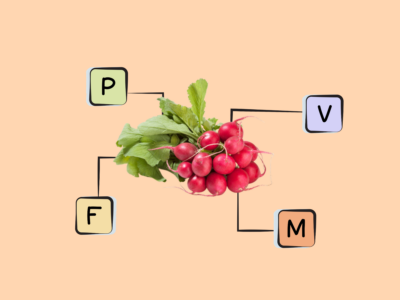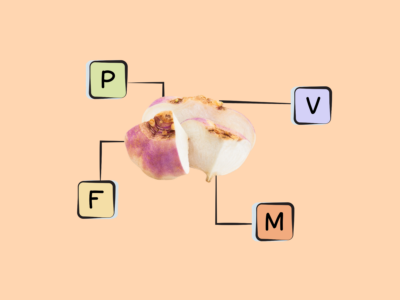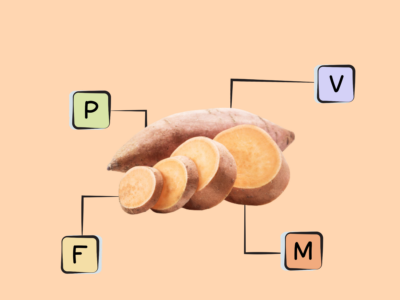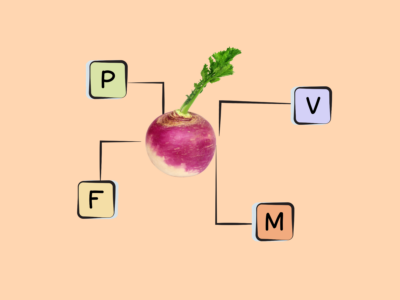Table of Contents[Hide][Show]
Health Benefits of Root Vegetables
Root vegetables support human health in a number of ways, with different veggies offering unique benefits (read: the wider the variety we eat, the better!). Root vegetables are any underground plant part consumed as vegetables, though not all of them are “true” roots. Botanically, bulbs like onions, corms like taro, rhizomes like ginger, and tubers like potatoes aren’t actually roots, but in the culinary world, they all count! Even winter squash, which are botanically fruit, are typically included in the root vegetable family because they are nutritionally and culinarily similar.
Root vegetables originate from all around the globe, and were one of the earliest foods consumed by humans. Even today, in many parts of the world, root vegetables are more important as a staple food than grains, especially in West and Central Africa and Oceana. This is due to both their versatility and their ability to store without spoiling for long periods after being harvested. Nutritionally, root vegetables vary in their composition, but due to their role as storage organs (storing nutrients and energy for the rest of the plant), they tend to be nutrient-dense, containing slow-burning carbohydrates and abundant in vitamins, minerals, phytonutrients, and fiber.
A 2019 review of evidence from meta-analyses evaluated the relationship between dietary components and risk of CVD and all-cause mortality. Researchers found that for every 100 grams per day increase in root vegetable intake there was a 24% reduced risk of all-cause mortality. Wow! That’s huge, and in fact, the highest magnitude of benefit compared to all other vegetable and fruit families.
Another 2012 study evaluated data from the European Prospective Investigation into Cancer (EPIC)-InterAct study which looked at the impact of fruit and vegetable intake on the incidence of type 2 diabetes. Comparing highest with lowest quartile of intake, among fruit and vegetable sub-types, only root vegetables were inversely associated with diabetes, demonstrating a 13% reduced risk!
There’s also evidence that root vegetables, especially starchy options like sweet potatoes and parsnips, improve sleep. Our bodies seem primed for slow-burning starchy carbohydrates, such as those found in root veggies, in the evening. We produce more starch-digesting enzymes in the evening, and studies show that eating a decent quantity (say something like 30 grams) of starchy carbs from whole food sources at dinner significantly improves sleep! Fiber intake also improves sleep quality and latency (how long it takes us to fall asleep) in addition to all the other good things fiber does. Root vegetables deliver both!
One of the most important ways that root vegetables benefit us is by supporting the gut health. This is because they contain a variety of carbohydrates that feed beneficial species of bacteria in the gut, including being especially awesome at supporting the growth of two particularly important genera of probiotic bacteria: Bifidobacterium and Lactobacillus. Bifidobacteria carry out a huge number of roles, including producing vitamins, preventing pathogens from colonizing the gut mucosa (including E. coli), protecting against yeast overgrowths, improving the gut barrier function, and reducing endotoxin transport. Likewise, lactobacilli (including the most widely used probiotic, Lactobacillus acidophilus) help inhibit the growth of pathogens such as H. pylori (through a process called “competitive exclusion”), and some species have anti-cancer and anti-diabetic effects. Basically, these bacteria are essential probiotic residents of a healthy gut, so it’s crazy important to make choices that support their growth! And, root veggies are well-proven promoters of these incredible microbes!
Along with containing fiber that enhances the growth of the beneficial bacteria, the prebiotics in root vegetables also enhance the production of short-chain fatty acids (SCFAs). SCFAs (including butyric acid, acetic acid, and propionic acid) are produced from fiber fermentation by specific bacteria groups in the gut. Along with serving as the main food source for intestinal epithelial cells, SCFAs offer an enormous list of benefits for our health, including reducing the risk of inflammatory diseases, protecting against obesity and diabetes, and reducing the risk of heart disease. And, it just so happens that the carbohydrates that get fermented into SCFAs are found abundantly in most root vegetables, such as pectin (high in carrots), fructooligosaccharides (abundant in Jerusalem artichokes, burdock root, chicory root, and yacón), and resistant starch in the form of RS3 (high in cassava and cooked and cooled potatoes).
Overall, root vegetables are absolute rock stars when it comes to our health!
The 3 Simplest Ways to Eat a Healthy Diet

Essential Eating Patterns for Lifelong Health
Learn the three science-backed eating patterns that support lifelong health, regardless of what diet you follow.
In this webinar, Dr. Sarah guides you to adopt these impactful eating patterns, embrace a permissive dietary structure, incorporate quality-of-life foods, and make small changes that collectively add up to make a substantial difference in your overall health.
Buy now for instant digital access.
Examples of Root Vegetables
- acorn squash
- arrowroot
- bamboo shoot
- beet root
- butternut squash
- carrot
- cassava (aka tapioca, yuca)
- celeriac
- daikon
- delicata squash
- ginger
- Hubbard squash
- Jerusalem artichoke
- jicama
- kabocha squash
- lotus root
- parsnip
- plantain
- potato
- pumpkin
- radish
- rutabaga
- spaghetti squash
- sweet potato
- taro
- tiger nut
- turnip
- water chestnut
- yam
Nutrivore Is a Game-Changer—This FREE Guide Shows You Why
Sign up for the free Nutrivore Newsletter, your weekly, science-backed guide to improving health through nutrient-rich foods — without dieting harder —and get the Beginner’s Guide to Nutrivore delivered straight to your inbox!

Nutrients in Root Vegetables
Easily track your servings of Nutrivore Foundational Foods!

The Nutrivore Weekly Serving Matrix
The Nutrivore Weekly Serving Matrix digital resource is an easy-to-use and flexible weekly checklist designed to help you maximize nutrient-density and meet serving suggestions of Nutrivore foundational foods, all without having to weigh or measure your foods!
Includes a 22-page instructional guide and downloadable interactive guides.
Buy now for instant digital access.
Help me to keep building Nutrivore.com

I’m working on writing more awesome articles on this topic to be featured right here on this webpage. If you’re enjoying the content my team and I have created thus far and would like to see more, you can support our efforts to keep building out this site by joining the Nutrivore community on Patreon!
Plus every month, you’ll gain exclusive and early access to a variety of resources, including a weekly video podcast, a new e-book in a series, nutrient fun factsheet, and more! Sign up now and also get 5 free Nutrivore guides as a welcome gift! Win-win-win!
Citations
Expand to see all scientific references for this article.
Asadi K, et al. “Cancer-preventive Properties of an Anthocyanin-enriched Sweet Potato in the APC MIN Mouse Model.” J Cancer Prev. 2017 Sep;22(3):135-146. doi: 10.15430/JCP.2017.22.3.135. Epub 2017 Sep 30.
Babic I, et al. “Antimicrobial activity of shredded carrot extracts on food-borne bacteria and yeast.” J Appl Bacteriol. 1994 Feb;76(2):135-41.
Banno T, et al. “Sweet Potato Improves Defecation and Gut Microbiota of Female University Students.” Nippon Eiyo Shokuryo Gakkaishi. 2016;69(5):229-235.
Barszcz M, et al. “The effects of inulin, dried Jerusalem artichoke tuber and a multispecies probiotic preparation on microbiota ecology and immune status of the large intestine in young pigs.” Arch Anim Nutr. 2016 Aug;70(4):278-92. doi: 10.1080/1745039X.2016.1184368.
Caetano BF, et al. “Yacon (Smallanthus sonchifolius) as a Food Supplement: Health-Promoting Benefits of Fructooligosaccharides.” Nutrients. 2016 Jul 21;8(7). pii: E436. doi: 10.3390/nu8070436.
Campos D, et al. “Prebiotic effects of yacon (Smallanthus sonchifolius Poepp. & Endl), a source of fructooligosaccharides and phenolic compounds with antioxidant activity.” Food Chem. 2012 Dec 1;135(3):1592-9. doi: 10.1016/j.foodchem.2012.05.088. Epub 2012 May 30.
Castaner O, et al. “The Gut Microbiome Profile in Obesity: A Systematic Review.” Int J Endocrinol. 2018 Mar 22;2018:4095789. doi: 10.1155/2018/4095789. eCollection 2018.
Chiu C-S, et al. “Diosgenin ameliorates cognition deficit and attenuates oxidative damage in senescent mice induced by D-galactose.” Am J Chin Med. 2011;39(3):551-63. doi: 10.1142/S0192415X11009020.
Cho J, et al. “Antioxidant and memory enhancing effects of purple sweet potato anthocyanin and cordyceps mushroom extract.” Arch Pharm Res. 2003 Oct;26(10):821-5. doi: 10.1007/BF02980027.
Cooper AJ, Forouhi NG, Ye Z, Buijsse B, Arriola L, Balkau B, Barricarte A, Beulens JW, Boeing H, Büchner FL, Dahm CC, de Lauzon-Guillain B, Fagherazzi G, Franks PW, Gonzalez C, Grioni S, Kaaks R, Key TJ, Masala G, Navarro C, Nilsson P, Overvad K, Panico S, Ramón Quirós J, Rolandsson O, Roswall N, Sacerdote C, Sánchez MJ, Slimani N, Sluijs I, Spijkerman AM, Teucher B, Tjonneland A, Tumino R, Sharp SJ, Langenberg C, Feskens EJ, Riboli E, Wareham NJ; InterAct Consortium. Fruit and vegetable intake and type 2 diabetes: EPIC-InterAct prospective study and meta-analysis. Eur J Clin Nutr. 2012 Oct;66(10):1082-92. doi: 10.1038/ejcn.2012.85. Epub 2012 Aug 1.
de Souza CB, et al. “Prebiotic effects of cassava bagasse in TNO’s in vitro model of the colon in lean versus obese microbiota.” Journal of Functional Foods. Nov 2014;11:210-220.
Geyer M, et al. “Effect of yacon (Smallanthus sonchifolius) on colonic transit time in healthy volunteers.” Digestion. 2008;78(1):30-3. doi: 10.1159/000155214. Epub 2008 Sep 10.
Harfilia H, et al. “Prebiotic potential of xylooligosaccharides derived from cassava dregs in Balb/c mice colon.” Pertanika Journal of Tropical Agricultural Science. 2018;41(3):1021-1031.
Helen O, et al. “Dioscorea alata L. Reduces Body Weight by Reducing Food Intake and Fasting Blood Glucose Level.” British Journal of Medicine and Medical Research 2013 Oct-Dec; 3(4).
Hong E & Kim G-H. “Anticancer and Antimicrobial Activities of β-Phenylethyl Isothiocyanate in Brassica rapa L.” Food Science and Technology Research 2008 Jul;14(4):377-382. doi: 10.3136/fstr.14.377.
Jesus M, et al. “Diosgenin: Recent Highlights on Pharmacology and Analytical Methodology.” J Anal Methods Chem. 2016;2016:4156293. doi: 10.1155/2016/4156293. Epub 2016 Dec 28.
Kawakami S, et al. “Potato powders prepared by successive cooking-process depending on resistant starch content affect the intestinal fermentation in rats.” Biosci Biotechnol Biochem. 2017 Feb;81(2):359-364. doi: 10.1080/09168451.2016.1254537. Epub 2016 Nov 11.
Kurdi P & Hansawasdi C. “Assessment of the prebiotic potential of oligosaccharide mixtures from rice bran and cassava pulp.” LWT – Food Science and Technology. Oct 2015;6(2):1288-1293.
Kwok CS, Gulati M, Michos ED, Potts J, Wu P, Watson L, Loke YK, Mallen C, Mamas MA. Dietary components and risk of cardiovascular disease and all-cause mortality: a review of evidence from meta-analyses. Eur J Prev Cardiol. 2019 Sep;26(13):1415-1429. doi: 10.1177/2047487319843667. Epub 2019 Apr 11.
LeBlay G, et al. “Enhancement of butyrate production in the rat caecocolonic tract by long-term ingestion of resistant potato starch.” Br J Nutr. 1999 Nov;82(5):419-26.
Lertwanawatana P, et al. “High pressure intensification of cassava resistant starch (RS3) yields.” Food Chem. 2015 Aug 15;181:85-93. doi: 10.1016/j.foodchem.2015.02.005. Epub 2015 Feb 21.
Lesmes U, et al. “Effects of resistant starch type III polymorphs on human colon microbiota and short chain fatty acids in human gut models.” J Agric Food Chem. 2008 Jul 9;56(13):5415-21. doi: 10.1021/jf800284d. Epub 2008 Jun 11.
Li D, et al. “Prebiotic effectiveness of inulin extracted from edible burdock.” Anaerobe. 2008 Feb;14(1):29-34. Epub 2007 Nov 26.
Li J, et al. “Purple sweet potato color attenuates high fat-induced neuroinflammation in mouse brain by inhibiting MAPK and NF-κB activation.” Mol Med Rep. 2018 Mar;17(3):4823-4831. doi: 10.3892/mmr.2018.8440. Epub 2018 Jan 17.
Lim S, et al. “Role of anthocyanin-enriched purple-fleshed sweet potato p40 in colorectal cancer prevention.” Mol Nutr Food Res. 2013 Nov;57(11):1908-17. doi: 10.1002/mnfr.201300040. Epub 2013 Jun 19.
Lin F, et al. “Purification and identification of antimicrobial sesquiterpene lactones from yacon (Smallanthus sonchifolius) leaves.” Biosci Biotechnol Biochem. 2003 Oct;67(10):2154-9.
Muchiri M & AL McCartney. “In vitro investigation of orange fleshed sweet potato prebiotic potential and its implication on human gut health.” Functional Foods in Health and Disease. 2017;7:833. 10.31989/ffhd.v7i10.361.
Osundahunsi OF, et al. “Prebiotic effects of cassava fibre as an ingredient in cracker-like products.” Food Funct. 2012 Feb;3(2):159-63. doi: 10.1039/c1fo10183h. Epub 2011 Nov 22.
Paul S, et al. “Phytochemical and Health-Beneficial Progress of Turnip (Brassica rapa).” J Food Sci. 2019 Jan;84(1):19-30. doi: 10.1111/1750-3841.14417. Epub 2018 Dec 18.
Sabater-Molina M, et al. “Dietary fructooligosaccharides and potential benefits on health.” J Physiol Biochem. 2009 Sep;65(3):315-28. doi: 10.1007/BF03180584.
Samal L, et al. “Prebiotic potential of Jerusalem artichoke (Helianthus tuberosus L.) in Wistar rats: effects of levels of supplementation on hindgut fermentation, intestinal morphology, blood metabolites and immune response.” J Sci Food Agric. 2015 Jun;95(8):1689-96. doi: 10.1002/jsfa.6873. Epub 2014 Sep 25.
Shan Q, et al. “Purple sweet potato color ameliorates cognition deficits and attenuates oxidative damage and inflammation in aging mouse brain induced by d-galactose.” J Biomed Biotechnol. 2009;2009:564737. doi: 10.1155/2009/564737. Epub 2009 Oct 26.
Son S, et al. “Antioxidant and Anti-inflammatory Effects of Yam (Dioscorea batatas Decne.) on Azoxymethane-induced Colonic Aberrant Crypt Foci in F344 Rats.” Prev Nutr Food Sci. 2014 Jun;19(2):82-8. doi: 10.3746/pnf.2014.19.2.082.
Sugimoto S, et al. “Photoprotective effects of Bifidobacterium breve supplementation against skin damage induced by ultraviolet irradiation in hairless mice.” Photodermatol Photoimmunol Photomed. 2012 Dec;28(6):312-9. doi: 10.1111/phpp.12006.
Sun H, et al. “Antioxidant and prebiotic activity of five peonidin-based anthocyanins extracted from purple sweet potato (Ipomoea batatas (L.) Lam.).” Sci Rep. 2018 Mar 22;8(1):5018. doi: 10.1038/s41598-018-23397-0.
Tang C, et al. “Effects of polysaccharides from purple sweet potatoes on immune response and gut microbiota composition in normal and cyclophosphamide treated mice.” Food Funct. 2018 Feb 21;9(2):937-950. doi: 10.1039/c7fo01302g.
Tohda C, et al. “Diosgenin-Rich Yam Extract Enhances Cognitive Function: A Placebo-Controlled, Randomized, Double-Blind, Crossover Study of Healthy Adults.” Nutrients. 2017 Oct 24;9(10):1160. doi: 10.3390/nu9101160.
Valdovska A, et al. “Alternative for improving gut microbiota: use of Jerusalem artichoke and probiotics in diet of weaned piglets.” Pol J Vet Sci. 2014;17(1):61-9.
Velez E, et al. “Study of the effect exerted by fructo-oligosaccharides from yacon (Smallanthus sonchifolius) root flour in an intestinal infection model with Salmonella Typhimurium.” Br J Nutr. 2013 Jun;109(11):1971-9. doi: 10.1017/S0007114512004230. Epub 2012 Nov 9.
Wang M, et al. “Apigenin Impacts the Growth of the Gut Microbiota and Alters the Gene Expression of Enterococcus.” Molecules. 2017 Aug 3;22(8):1292. doi: 10.3390/molecules22081292.
Wang S, et al. “Chemical constituents and health effects of sweet potato.” Food Res Int. 2016 Nov;89(Pt 1):90-116. doi: 10.1016/j.foodres.2016.08.032. Epub 2016 Aug 27.
Yang L, et al. “The prospects of Jerusalem artichoke in functional food ingredients and bioenergy production.” Biotechnol Rep (Amst). 2014 Dec 13;5:77-88. doi: 10.1016/j.btre.2014.12.004. eCollection 2015 Mar.
Yang X, et al. “Resistant Starch Regulates Gut Microbiota: Structure, Biochemistry and Cell Signalling.” Cell Physiol Biochem. 2017;42(1):306-318. doi: 10.1159/000477386. Epub 2017 May 25.



